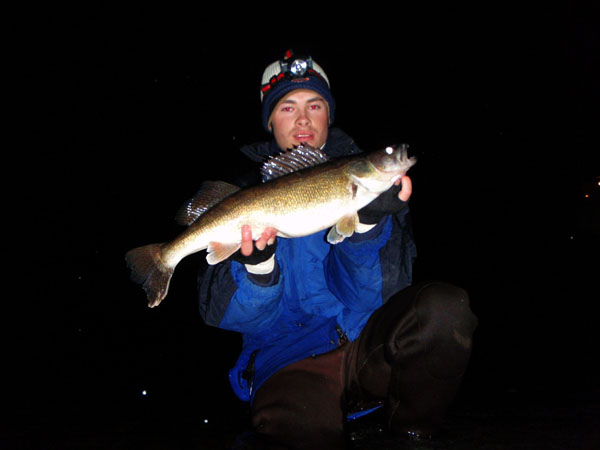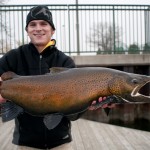If you can brave the colder air and water temperatures and navigate and wade your way around rivers in darkness, fall walleye fishing can be a tremendous amount of fun. Many anglers turn to the autumn season for deer hunting and sitting on the couch for weekend football. But for those of us who are aware of the madness that occurs on our local river systems after dark, the fall season is simply the best time of the year for catching big river walleyes.
I’ve observed that fall fishing just about anywhere in the Midwest can be a lonely event. For the first time all year, it feels strange to have so much water available to yourself and a few other diehards. What are the odds of having the entire river all to you? In this day and age of increased angling pressure and the popularity of fishing, you get the feeling that something must be wrong with this picture. But don’t be concerned about it. Chances are that nothing is wrong and everything is right.
During my last five seasons of fishing, the months of October and November have proven to be my most productive period for catching big walleyes. Fishing during the fall months on any river system throughout the Midwest leads to the biggest catches of fish than at any other time of the year.
Motivated to Migrate

As the end of summer rolls into fall, seasonal triggers such as cooling water temperatures, less daylight, and baitfish migrations occur. Consequently, these occurrences send schooling walleye on an upstream river migration. These upstream migrations usually lead walleyes several miles away from their previously known locations. Many fish species, including walleye, migrate in search of food, sometimes over considerable distances despite the increased risk of predation and harvest. This explains why walleye are nocturnal and will predominantly run at night; to evade harm, and to prey on the less adapted diurnal forage species.
As water temperatures cool down into the 55 to 60 degree range, usually beginning in late September for much of the Midwest, the fish become restless and go on the move during the nighttime hours. They retreat from their summertime deep water locations for areas with more gradient and current, shallower pools with rocky habitat, and more abundant food sources. Walleyes will stay active and be on the move for several weeks until water temperatures eventually drop into the 40 degree range. Usually this occurs by end of November. Fish receive the signals that winter is near and their metabolism will slow. By then they will start retreating to their wintering holes and grow difficult to catch.
Just like the spring spawning season, the fall migration creates a high concentration of fish. However, unlike the spring when fish are on the move to reproduce, the purpose for the fall migrations are for the fish to feed and store fat content for winter survival. Hence, the fall run is referred to as a feeding migration.
Walleye Locations

On any Midwestern river system, walleyes tend to spread out and solitarily roam the waters throughout the year. Fall walleyes, on the other hand, tend to migrate in schools, and are found in concentrated numbers. In addition, they become much more active, and feed aggressively all day long.
Active walleyes that are located in identifiable locations lead to peak fishing conditions. Locating these fish is the first piece of the puzzle.
The majority of my searches for productive water usually begins by consulting with fellow river rats and then browsing online satellite maps for locating potential water including access sites. By studying satellite maps, I’m often able to pick out areas with current, riffle runs, pools, and likely holes without needing to see the river firsthand. Since most of my fall walleye fishing occurs after dark, I will always do the preliminary research beforehand during the daytime, especially if I need to visit the area to test the waters and see it for myself. It’s best to know where you will be fishing and wading the river if you can see it. Otherwise you could be asking for trouble by doing it as you get there at night.
Another productive means for locating fish is by heading as far upstream as known the fish can travel. From there, begin methodically wading and casting your way downstream, covering every hole and pool encountered. Good starting points for me are dams or any other barriers preventing further migration. Despite the increased angling pressure dams and other similar landmarks receive, these are the some of the best places to begin an outing.

During autumn, walleyes tend to relate to deeper pools that are just downstream of dams and large rocky riffle runs. On wadeable rivers and their tributaries, these pools are usually anywhere from 3 to 6 foot deep. The river in the most productive pools will have current flow that is in a low to mid-gradient state, and the bottom will be littered with underwater obstructions such as rocks, boulders, and even wood. This underwater structure tends to attract forage species such as perch, suckers, chubs, shad, and other pelagic baitfish species. Consequently, due to the refuge provided by these areas, as well as their food source aspects, walleyes will consistently stage and roam through these areas, utilizing the both structure and the smorgasbord of available prey.
Besides dams and riffle runs, other areas such as gravel bars, wing dams, and deeper shoreline holes that create eddies will consistently hold fish throughout fall. These areas serve as outlets from the current. They are all prone to hold fish because they have depth, shape and deflect the current, and can be accessed by wading from the shallow upstream sides and casting directly into the deeper pools they create downstream.
To locate walleyes during fall, I have learned that it’s best to try fishing multiple areas throughout the night rather than rely on solely one area. Since fish are on the move, peak fishing is maximized by fishing these high percentage areas due to their likelihood of holding fish at any time. Based on my experiences, spot-hopping until fish are located is the best way to stay productive and gives anglers the best chance at consistently catching them. Lastly, if the moon is shining overhead, use that to your advantage as the majority of my nighttime river walleyes are caught under brighter conditions.
Choose Rivers Wisely

Most rivers do not fish the same and unfortunately, not all of them provide great walleye fishing. Most normal river systems are comprised of great habitat ranging from hard-bottomed rock, boulder, and gravel, to stretches with sand, mud, and wood. In addition, they may have well defined channels, distinct pools and holes, and a combination of current with slackwater. However, these factors are not the deciding points for me in whether the river is worthwhile to fish or not. In order to determine the productiveness of a river, there are a few different things to examine.
First, I check the amount of dams on the particular river system. Without question, dams greatly reduce the amount of walleyes in a river system, regardless of stocking programs or not. Worst of all, they prevent seasonal fish migrations from occurring for a variety of species. In this scenario, walleyes are a victim of dams. Once they reach the impassible barrier, their upstream run is over. In some situations, dams even prevent natural reproduction from taking place. The quality of fishing can be greatly improved by reducing the number of dams.

Individual experience suggests that dams truly do prevent good fishing from taking place. This proof came to me during October and November, 2010.
Every fall, a group from Fishing-Headquarters gathers at a Northern Illinois river of our choice for a period of 8 weeks to enjoy the camaraderie and to catch fish after work. In previous years our walleye league nights were held with success along the heavily overlooked and very productive Des Plaines River. However, a few spirited anglers decided switch our locations for 2010, forcing our league nights to take place at various landmarks along the more convenient for them, and less productive, Fox River.
The Fox River is a medium sized river, flowing 115 miles in Northern Illinois from Antioch, through the famed Chain O’ Lakes, then southward past several of Chicago’s furthest west suburbs and communities before emptying into the Illinois River. Along the way, there are 15 dams which the river flows through, with several of them being only 5 to 10 miles apart from one another.
In addition to dams, it’s no secret that places with current attract fish. Many of my best walleye streams have equal amounts of current with slackwater areas that provide refuge. Current is beneficial to walleyes in several ways: It provides dissolved oxygen content required for survival throughout the year. It also traps struggling baitfish and forces them downstream to anticipating feeding walleyes. Current leads to reduced visibility for everything in the river system, and causes baitfish to become disoriented. Due to their excellent vision, and natural instincts to keep keel with the river bottom, walleye take full advantage of everything that comes to them through the current.
Another thing I look for is whether my river system interconnects with other tributaries, and flows into reservoirs. Throughout states such as Wisconsin, Minnesota, and the Dakotas, several river systems possess outstanding walleye fisheries because fish have miles upon miles of water to make their seasonal movements. I have had my best success fishing river systems that have these “open water” qualities where fish can migrate upstream from the reservoirs up into the river and vice-versa without having to worry about barriers. Consequently these inland waters contain the highest populations of fish that can be found anywhere in the Midwest.
Finally, most of my best rivers are fished when current flow is stable and water levels stay consistent throughout the entire months of October and November. Heavy periods of rainfall during autumn are detrimental to good walleye fishing on rivers. For all species of fish, flooding and increased water levels push fish tight to shore and makes wading impossible and unsafe. Since walleyes roam the open basins of rivers, chances for any good fishing during high water are lost. Despite that, occasional rainfall is actually a benefit for fishing. The run-off from rainfall and its receding waters thereafter initiates an intense fall bite and triggers increased feeding. In addition, rising water levels spur walleye activity and make good conditions turn even better.
Gear and Tackle
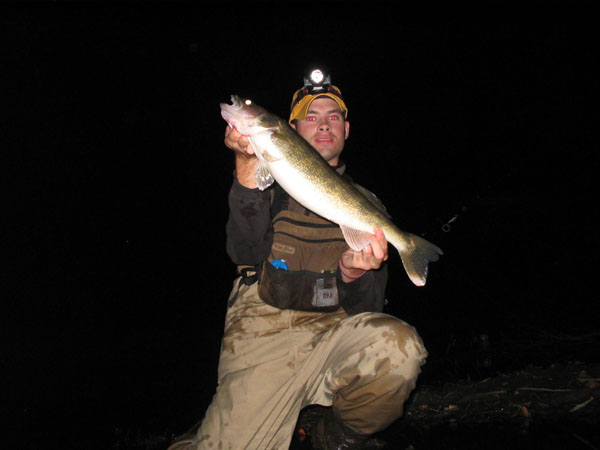
I like to fish with a variety of baits throughout the fall. Without question, matching the hatch with a larger profile minnowbait is the most productive method for landing the big ones.
When fishing at night during October and November, my motto is go big or go home. The reasons being are that most species of baitfish have reached their adult sizes by late season. Also, larger walleyes tend to prefer larger prey over anything else in order to conserve their energy levels.
In most situations I fish with medium to large sized minnow baits. Preferred sizes are in the range of 3 to 8 inches in length. Some recommended favorites are F9, F11, and even F13 Floating Rapalas. In addition, other minnowbaits such as suspending models are dangerous on walleyes. These include Smithwick Rogues, Rebel Minnows, Husky Jerks, and XR 8 and 10 Rapala X-Raps. In addition, sinking minnows such as the CD07 and 09 Countdown Rapalas are effective in pools where depth is greater than 5 feet.


I have actually noticed that color choice plays an important role with minnowbaits. Matching the hatch is critical due to the presence of baitfish and preyfish in several areas frequented by walleyes. Because of this, and also due to the improved water clarity as temperatures keep getting colder, I always use natural colors. Some of my best all-around patterns are anything resembling shad, shiners, suckers, and yellow perch. However, there are times following rainfall when water clarity becomes reduced. In these situations, unnatural colors such as hot orange, firetiger, and yellow entice strikes.
It is important to make long casts perpendicular and downstream with the current flow of the river when fishing with minnowbaits. Oftentimes, retrieving the lure at a steady pace and exerting its wobble and vibration triggers strikes. If there is current, let it do most of the work during the retrieve. As for suspending minnowbaits, it is best to retrieve them with occasional jerks and pauses. It pays to experiment and to retrieve the baits according to the moods and activity levels of the fish.
In addition to the old standby minnowbait, jigs and plastics are reliable producers. In some situations they even work better than the hard bodied artificials. I fare best with plastics during the daytime hours. They work especially well in periods following a cold front and when the fish are tight-lipped either due to weather factors or if they grow conditioned to certain lures and angling pressure. I tend to use plastics the least, but some favorites are Lindy Tackle’s Munchie grubs rigged with 1/8 oz. to ¼ oz. jigs, and 4 inch Walleye Assassins, a slender swimbait with a paddle tail that is best fished with an 1/8 oz. long shank darter head jig.
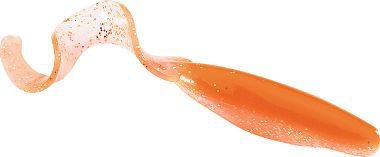
When it comes to choosing colors for plastics, I’ve often had my best success fishing with bright unnatural colors such as orange and chartreuse. However, natural colors including white, pearl, smoke, and pumpkin may also entice strikes often during daylight. Usually jig head color doesn’t play a role in my success because the fish are focused on the profile and action of the plastic rather than the color of the jig itself. As far as retrieve goes, I frequently like to swim plastics through the water column at varying depths. In addition, I also snap jig and bounce along the bottom providing that it is clear of snags and other debris.
The larger the river system, the heavier the tackle I use. I often wade with two rods on me, because in cold temperatures it’s an inconvenience to frequently retie new lures. On most rivers I fish, and especially for fishing with minnowbaits, I use a 7 foot medium fast action rod with 8 lb. abrasion resistant, easy casting copolymer line. Sometimes a light braided superline works for preventing snags and making longer casts, but I dislike the way it handles because it imparts less action on the baits. If I use plastics and want to snap jig my way along the bottom or swim it through the water, I use a shorter 6 and a half foot medium action rod and a reel with 6 lb. abrasion resistant copolymer.
Besides rods and reels, and a healthy selection of baits, owning a good set of waders and wearing warm clothing in the darkness of 30 and 40 degree air temperatures are the most important pieces of equipment a nighttime walleye angler should have. Due to water temperatures falling into the 40 degree range, neoprene waders with an interior liner are recommended for keeping warm. I tend to wear fabrics with a thickness less than 2 mm. due to increased mobility and better comfort. However, at times, breathable waders can be used, providing that several layers of clothing are worn underneath. And as far as clothing is concerned, bundling up and wearing layers underneath is advised.
Standing in the middle of a river in above-freezing temperatures for hours at a time can take a toll on one’s body. Exposure to the cold while fishing is the worst thing that can happen. Always dress warm and have a set of gloves and a hat. It wouldn’t be a bad idea to have some hand warmers either. Keeping warm while catching fish will make you want to fish for walleyes every night during the midnight madness of fall.
Fish with a Buddy
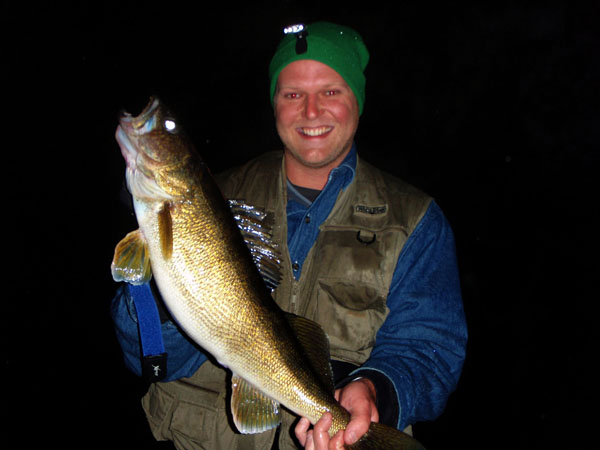
During my past few seasons of fall fishing, I’ve witnessed that the nights spent fishing are best enjoyed alongside the company of friends and other anglers alike. Catching walleyes and enjoying the camaraderie makes the dwindling fall season all the more worthwhile. If it’s cold out, chances are that you likely won’t feel it.
Do yourselves a favor as you hit the rivers for walleyes in the upcoming months. Meet up with some friends, form a weeknight walleye league, and have a social afterwards. Go enjoy the midnight madness of fall. The big fish are out there, and more abundant than ever before. Strap down, bundle up, and wade to some of the largest walleyes you will encounter all season. After all, it is better to fish late rather than never.
